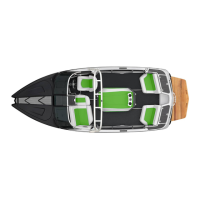2017 OWNERS MANUAL / 12
WEIGHT LIMITS
AND DISTRIBUTION
All boats have weight limits. Failure to adhere to the posted limits
can cause operation instability and/or the boat to sink. This may
result in serious injury or death, as well as significant damage to
the boat, which will not be covered by warranty.
Overloading a boat may cause it to become unstable and may
potentially result in the boat’s flotation system becoming over-
whelmed. Too much weight can sink any boat. Within this Owner’s
Manual and on a label mounted in each boat is the Maximum
Capacity for that specific model. Bear in mind that maximum limits
include additional water ballast bags and water put in them, gear
brought onto the boat, additional options and all people. Maximum
people is limited to the number of designated occupant seating
positions. Equally critical is how weight is distributed throughout the
boat. The weight must be distributed evenly throughout the boat.
If too much weight is placed in one area it can have serious impact
on maintaining control. Items and people can also shift positions
during operation, potentially causing a dangerous situation.
Adding weight of any type to the boat will aect the handling char-
• The U.S. Coast Guard, as well as MasterCraft, recommends the
wearing of PFDs at all times when the vessel is underway, even
though it is not a requirement. The best PFD is the one that is
worn and that can save your life.
• Inflatable PFDs must have a full cylinder and all status indicators
on the inflator must be green, or the device is NOT serviceable,
and is NOT considered a usable PFD for anyone on-board the
vessel.
• Coast Guard-approved inflatable PFDs are authorized for use on
recreational boats by persons at least 16 years of age.
• Some states require children to wear PFDs at all times. Check
with your state boating safety ocials for details. Be certain to
equip children with a PFD that is appropriate for the size of the
child. The label will indicate the weight limits for use.
NOTE: Requirements for coastal waters and inland waters dier.
Check with the local boating authorities for more information.
acteristics of the boat while it is underway. Caution should always
be exhibited when putting the boat into motion or
attempting to stop it, particularly when the added-weight
characteristics have changed.
LINE OF SIGHT
Care should also be taken to avoid interfering with the boat opera-
tor’s line of sight when the boat is underway. This applies particu-
larly to individuals riding in the bow. It is possible to quite uninten-
tionally obscure the driver’s view. Even momentary interference can
result in the driver’s inability to respond to a situation that requires
avoidance of another vessel or submerged or partially-submerged
objects. MasterCraft recommends using the driver seat bolster
or standing to maintain a safe lookout and proper visibility when
necessary. Everyone on board should always pay attention to other
vessels, people and objects located in close proximity to the boat,
activities taking place in or near the water, and should always be
supportive of the boat operator.
The law requires the boat operator to maintain clear visibility at all
times and in all directions when the boat is in motion.
PERSONAL FLOTATION DEVICES
(PFDS) AND ACCESSIBILITY
Federal law requires at least one wearable Type I, II, III
or Type V Personal Flotation Device (“PFD”) for each person
on-board or being towed on water skis, wakeboards, surfboards
or other recreational equipment. A Type V PFD provides perfor-
mance of either a Type I, II or III PFD (as marked on its label) and
must be used according to the label requirements. In addition,
one throwable Type IV PFD must also be on board. As the owner,
obtaining the appropriate PFDs is your responsibility. You must
also determine whether people on-board, including those who are
underage, are required to wear PFDs when underway. Your Master-
Craft dealer can, and will be happy to, assist you with your purchase
of appropriate PFDs.
People on-board who cannot swim or who are not strong
swimmers, as well as children, should wear PFDs at all times.
• Wearable PFDs must be readily accessible in the boat.
• It should be possible to put on the PFDs within a reasonable
amount of time in case of emergency.
• PFDs should never be stowed in plastic bags, in locked or closed
compartments or have other gear stowed on top of them.

